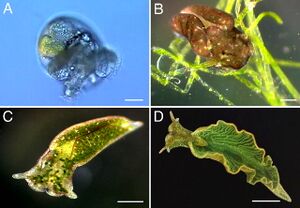Elysia chlorotica: Difference between revisions
No edit summary |
No edit summary |
||
| Line 8: | Line 8: | ||
<i>Elysia chlorotica</i> is small sized sea slug. It is bilaterally symmetrical like a real leaf. The adult individual are around 3~5 centimeters long. An <i>Elysia chlorotica</i> has two stages of development: juvenile and adult stages, which can be distinguish by its morphology and coloring. During juvenile stage, newly hatched <I>E. chlorotica</I> are usually translucent brown, with few red spots on their bodies. This stage remains until the initial feeding on algae,<I>Vaucheria litorea</I>. The <I>E. chlorotica</I> obtains chloroplast from the algae, preserving in its special digestive tract. The presence of chloroplast gradually turns the body color into bright green, and lost red spots.Elysid refers to the adult slug’s leaf-like shape which is caused by two large lateral parapodia on either side of its body. This morphology is beneficial as both camouflage and allowing the slug to be more efficient at photosynthesis. Other members of this family are distinguished by their parapodia in addition to bright coloring. | <i>Elysia chlorotica</i> is small sized sea slug. It is bilaterally symmetrical like a real leaf. The adult individual are around 3~5 centimeters long. An <i>Elysia chlorotica</i> has two stages of development: juvenile and adult stages, which can be distinguish by its morphology and coloring. During juvenile stage, newly hatched <I>E. chlorotica</I> are usually translucent brown, with few red spots on their bodies. This stage remains until the initial feeding on algae,<I>Vaucheria litorea</I>. The <I>E. chlorotica</I> obtains chloroplast from the algae, preserving in its special digestive tract. The presence of chloroplast gradually turns the body color into bright green, and lost red spots.Elysid refers to the adult slug’s leaf-like shape which is caused by two large lateral parapodia on either side of its body. This morphology is beneficial as both camouflage and allowing the slug to be more efficient at photosynthesis. Other members of this family are distinguished by their parapodia in addition to bright coloring. | ||
==Kleptoplasty== | ==Kleptoplasty== | ||
Kleptoplasty is a special symbiosis behavior that the chloroplast uptake by algal prey can remain temporarily function in the organism, which allows an animal doing photosynthesis like plants. Species in the clade Sacoglass (such as <i>E. | Kleptoplasty is a special symbiosis behavior that the chloroplast uptake by algal prey can remain temporarily function in the organism, which allows an animal doing photosynthesis like plants. Species in the clade Sacoglass (such as <i>E. chlorotica</i>) have this ability. The recent research indicates kleptoplasty can be obtained through lateral gene transfer from algae to the sea slug. (2) The symbiotic chloroplast in the organism remains functioning after 8 months starvation.(12333.full).The algal chloroplast gene has been actively transcript and translate in the sea slug, such as <i>rbcL, rbcS, psaB, psbA, and 16S rRNA</i> had been found in animal. Some of these genes encoded chlorophyll a/b (an important compound allows plant absorb energy from light and provide the green color of the plant). However, chloroplast in E. cholotica is not inheritable, the acquisition, usage and maintenance of kleptoplasty will appears on sea slug after they been feed on <I>Vaucheria litorea</I>. | ||
Revision as of 02:19, 7 December 2021
Introduction
Elysia chlorotica (or the eastern emerald elysia) is a type of sea slug that can do photosynthesis. It is a marine Gastropoda species in Plankobranchidae family, and clade in Sacoglossa. Elysia chlorotica have been found in salt marshes and ponds off the coast of the eastern states and in Nova Scotia, Canada.
Life cycle and Morphology
Elysia chlorotica is small sized sea slug. It is bilaterally symmetrical like a real leaf. The adult individual are around 3~5 centimeters long. An Elysia chlorotica has two stages of development: juvenile and adult stages, which can be distinguish by its morphology and coloring. During juvenile stage, newly hatched E. chlorotica are usually translucent brown, with few red spots on their bodies. This stage remains until the initial feeding on algae,Vaucheria litorea. The E. chlorotica obtains chloroplast from the algae, preserving in its special digestive tract. The presence of chloroplast gradually turns the body color into bright green, and lost red spots.Elysid refers to the adult slug’s leaf-like shape which is caused by two large lateral parapodia on either side of its body. This morphology is beneficial as both camouflage and allowing the slug to be more efficient at photosynthesis. Other members of this family are distinguished by their parapodia in addition to bright coloring.
Kleptoplasty
Kleptoplasty is a special symbiosis behavior that the chloroplast uptake by algal prey can remain temporarily function in the organism, which allows an animal doing photosynthesis like plants. Species in the clade Sacoglass (such as E. chlorotica) have this ability. The recent research indicates kleptoplasty can be obtained through lateral gene transfer from algae to the sea slug. (2) The symbiotic chloroplast in the organism remains functioning after 8 months starvation.(12333.full).The algal chloroplast gene has been actively transcript and translate in the sea slug, such as rbcL, rbcS, psaB, psbA, and 16S rRNA had been found in animal. Some of these genes encoded chlorophyll a/b (an important compound allows plant absorb energy from light and provide the green color of the plant). However, chloroplast in E. cholotica is not inheritable, the acquisition, usage and maintenance of kleptoplasty will appears on sea slug after they been feed on Vaucheria litorea.
Feeding
Conclusion
References
Rumpho, M. E., J. M. Worful, J. Lee, K. Kannan, M. S. Tyler, D. Bhattacharya, A. Moustafa, and J. R. Manhart. 2008. “Horizontal Gene Transfer of the Algal Nuclear Gene PsbO to the Photosynthetic Sea Slug Elysia Chlorotica.” Proceedings of the National Academy of Sciences 105 (46): 17867–71. https://doi.org/10.1073/pnas.0804968105.
Edited by Hao Yang, student of Joan Slonczewski,2021,Kenyon College.

